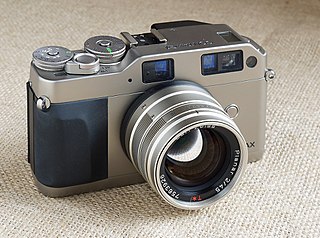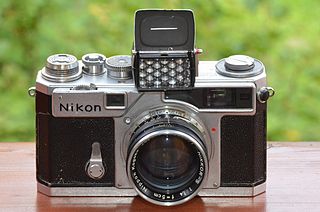
A single-lens reflex camera (SLR) is a camera that typically uses a mirror and prism system that permits the photographer to view through the lens and see exactly what will be captured. With twin lens reflex and rangefinder cameras, the viewed image could be significantly different from the final image. When the shutter button is pressed on most SLRs, the mirror flips out of the light path, allowing light to pass through to the light receptor and the image to be captured.

A rangefinder camera is a camera fitted with a rangefinder, typically a split-image rangefinder: a range-finding focusing mechanism allowing the photographer to measure the subject distance and take photographs that are in sharp focus. Most varieties of rangefinder show two images of the same subject, one of which moves when a calibrated wheel is turned; when the two images coincide and fuse into one, the distance can be read off the wheel. Older, non-coupled rangefinder cameras display the focusing distance and require the photographer to transfer the value to the lens focus ring; cameras without built-in rangefinders could have an external rangefinder fitted into the accessory shoe. Earlier cameras of this type had separate viewfinder and rangefinder windows; later the rangefinder was incorporated into the viewfinder. More modern designs have rangefinders coupled to the focusing mechanism so that the lens is focused correctly when the rangefinder images fuse; compare with the focusing screen in non-autofocus SLRs.

Carl Zeiss AG, branded as ZEISS, is a German manufacturer of optical systems and optoelectronics, founded in Jena, Germany in 1846 by optician Carl Zeiss. Together with Ernst Abbe and Otto Schott he laid the foundation for today's multi-national company. The current company emerged from a reunification of Carl Zeiss companies in East and West Germany with a consolidation phase in the 1990s. ZEISS is active in four business segments with approximately equal revenue in almost 50 countries, has 30 production sites and around 25 development sites worldwide.

Cosina Co., Ltd. is a manufacturer of high-end optical glass, optical precision equipment, cameras, video and electronic related equipment, based in Nakano, Nagano Prefecture, Japan.

Contax began as a German camera model in the Zeiss Ikon line in 1932, and later became a brand name. The early cameras were among the finest in the world, typically featuring high quality Zeiss interchangeable lenses. The final products under the Contax name were a line of 35 mm, medium format, and digital cameras engineered and manufactured by Japanese multinational Kyocera, and featuring modern Zeiss optics. In 2005, Kyocera announced that it would no longer produce Contax cameras. The rights to the brand are currently part of Carl Zeiss AG, but no Contax cameras are currently in production, and the brand is considered dormant.

The history of the single-lens reflex camera (SLR) begins with the use of a reflex mirror in a camera obscura described in 1676, but it took a long time for the design to succeed for photographic cameras. The first patent was granted in 1861, and the first cameras were produced in 1884, but while elegantly simple in concept, they were very complex in practice. One by one these complexities were overcome as optical and mechanical technology advanced, and in the 1960s the SLR camera became the preferred design for many high-end camera formats.

The Nikon FM10 is a manual focus 35 mm film camera sold by Nikon Corporation. It is of SLR design and was first available in 1995. It is normally sold in a kit that includes a Zoom Nikkor 35–70 mm f/3.5-4.8 zoom lens, although a Zoom Nikkor 70–210 mm f/4.5-5.6 zoom lens is also available. An electronic companion model known as the FE10 was also sold at one stage.

The M39 lens mount is a screw thread mounting system for attaching lenses to 35 mm cameras, primarily rangefinder (RF) Leicas. It is also the most common mount for Photographic enlarger lenses.

The Zeiss Sonnar is a photographic lens originally designed by Dr. Ludwig Bertele in 1929 and patented by Zeiss Ikon. It was notable for its relatively light weight, simple design and fast aperture.

Lens speed refers to the maximum aperture diameter, or minimum f-number, of a photographic lens. A lens with a larger than average maximum aperture is called a "fast lens" because it can achieve the same exposure as an average lens with a faster shutter speed. Conversely, a smaller maximum aperture is "slow" because it delivers less light intensity and requires a slower (longer) shutter speed.

The Contax G camera line consists of two cameras, the G1 and G2, interchangeable-lens cameras sold by Kyocera under the Contax brand in competition with the Leica M7, Cosina Voigtländer Bessa-R, and Konica Hexar RF. The G1 was introduced in 1994 with the G2 joining it in 1996. In 2005, Kyocera retreated from the camera business and announced it would cease all activity related to the manufacture of Contax cameras at the end of the year, effectively spelling the end of the G system.

The Nikon SP is a professional level, interchangeable lens, 35 mm film, rangefinder camera introduced in 1957. It is the culmination of Nikon's rangefinder development which started in 1948 with the Nikon I, and was "arguably the most advanced rangefinder of its time." It was manufactured by the Japanese optics company Nippon Kogaku K. K.. Three other lower featured rangefinder models were subsequently produced on the SP frame, and production continued into the 1960s, but further development of Nikon's professional rangefinders ended with the introduction and success of the single lens reflex Nikon F in 1959.

The Konica Hexar RF is a 35 mm rangefinder camera which was sold by Konica. It was introduced to the market on 13 October 1999. and subsequently discontinued some time before the end of 2003. The camera used the "Bayonet Konica KM-mount", a copy of the Leica M-mount, thus sharing interchangeable lenses with those designed for Leica cameras and others compatible with them. The Hexar RF has a combined rangefinder/viewfinder modeled on that of Leica cameras, a similar body shape and size - and so is similar to Leica M-mount cameras in many aspects of operation.

During the 1930s, Zeiss Ikon (ZI) made a wide range of miniature cameras for the 35mm film format. Most cameras used the standard 24×36 mm frame size, like the Contax, Nettax and Super Nettel. However, the ability to take images in fast sequence was a popular marketing element at the time, and several fast-operating models were made. Among these were the Otto Berning's motor-driven Robot cameras as well as the ZI lever-operated Tenax I and Tenax II. These have the smaller square format of 24×24 mm, enhancing faster frame advance.

The Leica copies originate from the Leica camera that was launched by Ernst Leitz, Wetzlar in 1925, using the Leica 39mm screw mount of 26 threads per inch, and the standard 35mm film. The design was carried out by Oskar Barnack, beginning in 1913 by building a camera for 24×36 mm negatives that by now is called the Ur-Leica; but Ernst Leitz did not decide to manufacture it until 1924. Once started, the Leica production volume doubled each year; in 1929, some 16.000 cameras were produced. In 1930, an improved model with interchangeable lens was introduced, followed a year later by the fully developed Leica II with standardized film to lens flange distance, and in 1932 the basic Leica Standard; the Leica concept was established. This camera's features are the basis for defining a Leica copy.

Biogon is the brand name of Carl Zeiss for a series of photographic camera lenses, first introduced in 1934. Biogons are typically wide-angle lenses.

The invention of the camera in the early 19th century led to an array of lens designs intended for photography. The problems of photographic lens design, creating a lens for a task that would cover a large, flat image plane, were well known even before the invention of photography due to the development of lenses to work with the focal plane of the camera obscura.

The Nikon was the first camera introduced by the optical manufacturer Nippon Kogaku KK. It is a 35mm rangefinder camera, in retrospect known as the Nikon I. The original design was approved by September 1946, and the camera was released in March 1948. At first, it was sold locally, and it did not come to the attention of the western media until 1950, when photographers from the magazine Life were shown photographs taken with these cameras. The lenses draw special attention, like the Nikkor-P.C 1:2 f=8.5cm. A demand to fit Nikkors to the reporters' Leicas were immediately met at the factory in Tokyo, and soon the word spread about these Japanese lenses which were just as good as, or possibly better than their German counterparts. The camera design was strongly inspired by the German Contax and Leica cameras. After careful studies of these, Nippon Kogaku had decided to base their camera on the Contax, but substitute the complicated shutter design for the cloth focal plane shutter of the Leica, these being considered the best features from either camera.

The Zeiss Hologon is an ultra wide-angle f=15mm f/8 triplet lens, providing a 110° angle of view for 35mm format cameras. The Hologon was originally fitted to a dedicated camera, the Zeiss Ikon Contarex Hologon in the late 1960s; as sales of that camera were poor and the Zeiss Ikon company itself was going bankrupt, an additional 225 lenses were made in Leica M mount and released for sale in 1972 as the only Zeiss-branded lenses for Leica rangefinders until the ZM line was released in 2005. The Hologon name was revived in 1994 for a recomputed f=16mm f/8 lens fitted to the Contax G series of rangefinder cameras.

The Nikon 35Ti (1993) and Nikon 28Ti (1994) are luxury titanium-clad point and shoot cameras that were produced by Nikon, equipped with a high-quality lens and body, competing with similar luxury compact cameras produced during the Japanese bubble-economy era, including the Contax T line, Konica Hexar, Leica minilux, Minolta TC-1, Ricoh GR series, and Rollei QZ 35W/35T. Both the 35Ti and 28Ti are 35 mm cameras with nearly identical operation; as the name implies, the 35Ti is equipped with a 35 mm focal length lens, while the 28Ti is equipped with a 28 mm lens. Externally, they may be distinguished by their color: the 35Ti is finished in chrome/silver, and the 28Ti is finished in black.





















